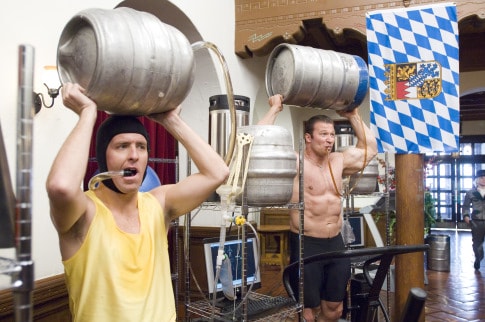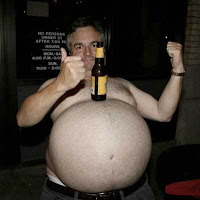I could not say "no" to reading this article,"
Becoming a beer expert: Is simple exposure with feedback sufficient to learn beer categories?" This study seemed simple on the surface but had a lot of depth to it. It was especially interesting for anyone wishing to further their beer knowledge and obtain their
Cicerone or
BJCP Judge designations. The principle of the study seemed simple enough. A group of students were put through a 70 hour long beer sensory course. During this course, students were presented with either top-fermented beers (TF) or bottom-fermented beers (BF) and asked to determine which was which. No names or images were shown, just a bunch of randomly appearing clear plastic cups. Rather like a BJCP judging contest. Many of the same TF and BF beers were repeated during each session while new beers in each category were introduced. As expected, after repeated exposure to the same beer, subjects recognized that same beer and could correctly identify it as either at TF or BF. However, subjects did not always answer correctly for the new beers they had not been previously exposed to. Then subjects were introduced to a trap beer. This trap was a TF beer that shared many sensory traits as a BF beer. A similar BF trap beer was also given. In case you were curious, the BF trap beer was
Biere du Demon and the TF trap beer was
Hoegaarden. Not surprisingly, not enough subjects correctly identified the trap beers compared to just guessing.
So what did this tell us about learning to be a beer pro? Not much that we didn't already know. You can identify beers that you are repeatedly exposed to, but might not be able to extend this knowledge to new beers. What was interesting and helpful was that it did explain how people learn about new experiences and remember them for latter. Many of these principles apply to learning beer styles. Much of this information was taken from learning about wine experts. Generally when we learn about something sensory we try to place it into a category (
categorization). We can do this in several methods, all with their pluses and faults. In this perceptual learning model, you learn to extract repeated stimulus and detect regularities. Sounds good right? Not so much, it expects you to pull sensory information from many different encounters. What if you only drink Fat Tug? Is so, then you think every single IPA should taste like Fat Tug. This is also why people only drink one kind of beer and nothing else. Your experience has told you that beer should taste this way, any deviation from this norm is rejected as incorrect.
So your drink a beer, learn those flavours and place these memories into categories. This is how you can pick out Pacific Northwest hops from European hops or Southern Hemisphere hops. With repeated training, many beer geeks can pick out specific hop varieties, malts used and yeast strains. This is done in several ways. The first is to use these sensory memories to create mental prototypes. In this method you create an ideal taste representation from presented examples in each category. This is what is done with BJCP beer training. Your learn about how an IPA, English mild or Saison by drinking the best known examples. You know what a Saison tastes like by drinking Dupont, Ommegang Hennepin and New Belgium Saison. Again this presents problems as mentioned above. If you can't find these beers, you have no idea what a proper Saison should taste like. I find this to be an issue with the Kolsch. Very few people, including brewers, may have never tasted a true Kolsch. This is a problem when you are presented with a can of local kolsch-like ale and assume this is what a true
Kolsch tastes like. I refer to this as the Analogue Phenomenon.
You also learn about beers from the feature-frequency theory. This is as it sounds, you build your models based on frequently occurring features of a recurring taste. IPAs frequently taste bitter, bocks are frequently sweet. This is quite handy for judging beer contests, but not much else. If a bock is excessively bitter, this is wrong. This again assumes you have lots of examples to draw from.
Another method is exemplar memorization. This again is just like it sounds, you memorized what a classic example tastes like. Possible issues in this method are that memories are fading and over time you might have forgotten what Saison Dupont tasted like. Perhaps your feature frequency from local saisons has caused the exemplar model to drift. To remedy this one should regularly sample the reference beer. Big breweries do this all the time, you regularly sample to same beer over and over for changes in flavour. I like the idea of drinking Saison Dupont every six months for research purposes. However, the typical beer geek, like me, rarely drinks the same beer twice so this form of learning is challenging.
So back to our beer students. What did thus study teach us about learning about beer. After questioning the students, the researchers found that there was no specific form of learning that was favoured. The results did seem to slightly favour the exemplar theory of learning as students to easily identify beers that they were repeatedly exposed to. However, the information from memorizing these flavours could not be extrapolated to new identifying new beer flavours. Researchers also felt that perhaps the sample size of beers was too small; this is perfect validation for my
Untappd score. So to learn more about beer, sample lots of different beers while looking for trends and analyze great beer style examples. Oh and drink Saison Dupont often.
 I admit that title was a tad shocking but I need to attract readership. It works for the newspapers, so I figured it would work for me. This title seems scary at first, "Short-term salivary acetaldehyde increase due
to direct exposure to alcoholic beverages as an additional cancer risk
factor beyond ethanol metabolism." One of the major off favours in beer is acetaldehyde, so we know it is present in some of the beers we drink. We also know that there tends to be more acetaldehyde present in lagers. Anyone who has judged a lager
category has gotten a mouthful of green apple. Acetaldehyde is a known risk factor for cancer. This compound in beer as associated with DNA damage and impaired DNA repair. So will drinking beer put you at risk of cancer? The answer is yes, but it is not as bad as you think.
I admit that title was a tad shocking but I need to attract readership. It works for the newspapers, so I figured it would work for me. This title seems scary at first, "Short-term salivary acetaldehyde increase due
to direct exposure to alcoholic beverages as an additional cancer risk
factor beyond ethanol metabolism." One of the major off favours in beer is acetaldehyde, so we know it is present in some of the beers we drink. We also know that there tends to be more acetaldehyde present in lagers. Anyone who has judged a lager
category has gotten a mouthful of green apple. Acetaldehyde is a known risk factor for cancer. This compound in beer as associated with DNA damage and impaired DNA repair. So will drinking beer put you at risk of cancer? The answer is yes, but it is not as bad as you think.
















